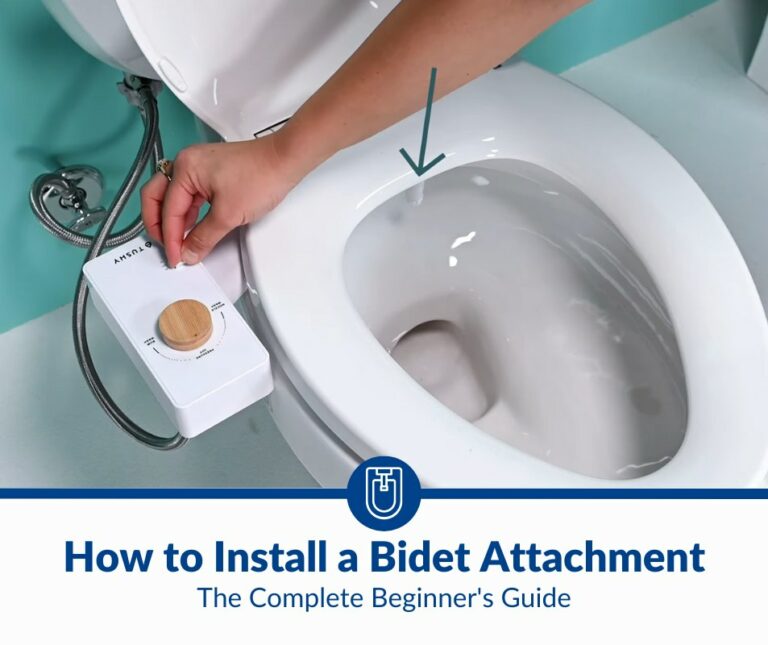Can Using a Bidet Cause Infection? Here’s the Truth
As more and more Americans embrace the idea of installing bidets in their washrooms, there is one concern that almost all interested parties have: can bidets cause infections? After all, this toilet fixture is meant to clean the nether regions after handling your business. So, how clean can it really be?
A bidet can cause infection if it’s not cleaned and disinfected correctly after use. That’s because the nozzle of an improperly maintained bidet can contain harmful bacteria, such as E. Coli. This is especially true for public bidets. However, properly maintained bidets are unlikely to cause infections.
Are you considering buying a bidet but are worried about its potential to cause infections? Read on for everything you need to know about this topic and more.
What Infections Can a Bidet Cause?
The vast majority of research on bidets shows that these bathroom fixtures are highly unlikely to cause infections. Nevertheless, considering the nature of a bidet’s job, one can see how these appliances can contribute to diseases.
As mentioned, the likelihood of getting an infection from using a bidet is much higher if you use a bidet whose nozzle contains traces of harmful microorganisms due to improper maintenance.
One study set out to determine the health risks of warm-water bidets in Japan. The study was conducted in Japan since up to 80% of the Island Nation’s population uses bidets, thus providing a good sample size.
Findings from the study revealed that poorly maintained bidet nozzles could contain a host of harmful bacteria, such as:
- E. Coli
- Staphylococcus aureus
- Enterococcus spp.
- Streptococcus spp.
- Stenotrophomonas maltophilia
The strains of bacteria above can be easily passed from one person to the next if the bidet’s nozzle is not sanitized correctly, thus resulting in cross-infection.
As such, the infection you can get from using a bidet depends on the particular bacteria strain that was present on the nozzle. For example, if your bidet’s nozzle had traces of E. Coli bacteria, you can expect symptoms associated with having E.Coli in your system.
However, the study above was conducted in a university hospital, which skews the findings quite a bit. That is because there is a higher likelihood of finding an infected person in a hospital, increasing the chances of finding traces of harmful bacteria on bidets in that location.
Additionally, hospital bidets are like public bidets; they experience a high amount of traffic. Consequently, they are more challenging to maintain.
As you can see, the likelihood of a bidet causing an infection depends on how well-maintained it is. That is why you are advised to buy self-cleaning bidets. These bidets typically come with self-sanitizing nozzles to keep bacteria at bay, thus avoiding cross-contamination.
And even if your bidet is of the self-cleaning kind, it is good practice to leave nothing to chance by cleaning the bidet thoroughly after use.
You can also reduce your chances of getting an infection from a bidet by avoiding public bidets. That is because public bidets are more likely to be poorly maintained due to the high amount of traffic they enjoy.
That said, there are a few health issues that can result from bidet use. However, these issues are highly dependent on the context or situation in which the bidet is used. Let’s have a look.
Potential Health Problems From Bidet Use
Bidets are generally safe for most users. However, some people can develop some anal complications from using these fixtures. According to this study, bidet use can cause anal pruritus and anal incontinence in some people. Excessive bidet use can also increase the risk of UTIs in women.
Anal Pruritus
Anal pruritus is a condition that can result from excessive bidet use. The constant washing of the anal area can reduce the amount of sebum in that region, resulting in dry skin. When that happens, the individual can be prone to itching in that area, resulting in anal fissures.
Anal pruritus is more likely to occur in people who use warm-water bidets.
As such, if you start experiencing an itch after using a bidet, there’s a good chance that you are overusing the bidet, reducing the amount of oil on the skin in your anal region. Nevertheless, it would be prudent to visit your doctor to ensure that’s the case and that you don’t have any other infection.
Anal Incontinence
Some people are unfortunate enough to experience anal incontinence due to bidet use. Also known as fecal incontinence, anal incontinence is a condition characterized by the inability to control bowel movements, resulting in feces coming out involuntarily.
It is believed that bidet use can cause anal incontinence when water enters the rectum, stimulating the defecation reflex.
In the study, a group of patients with AI were asked to stop using bidets for 4 weeks to determine whether these fixtures played a role in their condition. Findings revealed that the frequency of AI reduced significantly after discontinuing bidet use.
Nonetheless, anal incontinence can result from numerous causes. As such, bidets – in and of themselves – are highly unlikely to cause this issue without the existence of an underlying condition. This was illustrated by the fact that the majority of people who suffered anal incontinence from bidet use also happened to have a lax anal sphincter, which allowed water easier access to the rectum.
Increased Risk of Urinary Tract Infections in Women
Again, most women should have no issues using a bidet. However, the danger comes from excessive use, disrupting the healthy balance of vaginal flora.
The vagina contains healthy microbial organisms that protect it from infections. However, excessive use of bidets means that you will be effectively washing off some of that flora, reducing the organ’s ability to ward off infections.
This is especially true for bidets with frontal sprays, allowing them to wash the vagina directly. Handheld bidets are also more likely to reduce desirable vaginal flora since they enable the user to wash that part directly.
So, how should females use a bidet to avoid exposing themselves to such risks? Here are a few tips:
Go Easy on the Frontal Spray Mode
Bidets can come with a host of features to suit a user’s needs. Females prefer models with frontal sprays, as they allow them to clean the vaginal area effectively after using the bathroom.
Nonetheless, considering how dousing that area with water can result in the reduction of good vaginal flora, you are advised to limit the amount of time you spend using the frontal spray mode.
Doing that will reduce the risk of drying out vaginal mucosa, thus allowing you to maintain a healthy balance of beneficial microbial organisms in the vagina.
Reduce the Water Pressure
The inherent design of a female’s anatomy makes her more susceptible to UTIs from bidet use. That is because standard bidets spray the anal region with water to give it a cleansing, meaning there’s always the chance that some of that water could make its way to the woman’s vaginal area.
As such, females should reduce their bidet’s water pressure to prevent that from happening. Doing that will reduce the risk of the contaminated water working its way from the anus to the urethra.
How To Keep Your Bidet Clean
As we have established, a bidet is only going to cause an infection if it contains traces of disease-causing microorganisms. Therefore, the best way to prevent that is by ensuring your bidet is germ-free at all times. So, how do you do that?
Here are some tips:
Invest in a Self-Cleaning Bidet
As you can imagine, keeping a bidet germ-free can take up a lot of time. Hence, consider making your job easier by buying a bidet that comes with either self-cleaning or self-sanitizing capabilities.
What’s the difference between self-sanitizing and self-cleaning bidets, you ask?
Self-cleaning bidets, as their name suggests, typically cleanse themselves after use. However, they do not contain any anti-microbial properties. On the other hand, self-sanitizing bidets usually have unique anti-microbial properties to ensure disease-causing germs cannot exist on their nozzles.
For example, some self-sanitizing bidets have stainless steel surfaces treated with microbicidal elements, while others contain an antimicrobial solution for self-rinsing purposes.
Use Bidets With Retractable Wands
As mentioned, bidets come in varying designs – I’ll go deeper into this later. Unfortunately, some designs are inherently more challenging to keep clean, leave alone germ-free.
Most modern electric bidets have a push-pull feature that allows them to extend or retract the wand as needed. That means they only extend their wands when you need a wash; otherwise, it stays hidden in a protective housing.
One can see how this self-retracting mechanism makes bidet maintenance a breeze. For starters, the nozzle will not get contaminated by feces when you are handling your business, thus reducing the risk of UTIs. Moreover, since the wand is always out of the way unless needed, keeping it clean is typically a less messy undertaking.
That is why you should avoid bidets with non-retractable wands. These bidets typically feature a wand that swivels back and forth, allowing you to either push it down and out of the way or pull it up to use. As you can imagine, this design can be incredibly unhygienic, as you have to touch the wand with your own hands twice!
Have a Bidet Maintenance Schedule
Having a bidet cleaning/maintenance schedule will go a long way in ensuring your bidet stays germ-free. That’s because you are more likely to skimp on maintenance when you are not following a schedule, doing it only when you remember.
The frequency of bidet cleaning will depend on the particular model you have and the number of people using the fixture.
If you have a self-cleaning bidet, consider giving it a thorough clean at least twice a month. If it doesn’t have self-sanitizing capabilities, then ensure to wash it thoroughly using a sanitizer after every use.
Needless to say, if the whole household uses your bidet, ensure to leave clear instructions stating that each user should clean up after use.
Are There Any Benefits to Using a Bidet?
Now that we have established that bidets are not inherently unsafe, are there any actual benefits to using these fixtures?
It turns out that bidets might actually be better for you than toilet paper, and here’s why:
A Bidet Is Soothing and Leaves You Feeling Fresher
People who swear by bidets claim that these fixtures make their bums feel fresher and cleaner, not to mention how soothing the cleaning action is.
When you think about it, it does make sense. Wiping using toilet paper means scraping your bottom with a dry piece of paper. On the other hand, you don’t have to use toilet paper when you have a bidet. Instead, the fixture washes your bottom for you, removing all traces of poo.
As you can imagine, getting your behind washed by a gentle stream of water feels a lot better than rubbing a piece of paper against your anus’ sensitive skin.
Bidets Might Be More Sanitary Than Toilet Paper
When you use toilet paper (TP) to wipe, you are essentially smearing traces of poo around your anus. That means if you don’t wash immediately afterward, you’ll walk around with waste until the next time you shower.
Using a bidet ensures that you remove all evidence of poop from your bum, leaving you as fresh and clean as can be. Moreover, with a bidet, you don’t risk touching your poo as you would with TP, thus preventing the potential spread of fecal bacteria from your bum to your hands and, eventually, to others.
Bidets Are Better for People With Hemorrhoids and Fissures
Research shows that 1 in 20 Americans suffer from hemorrhoids. Additionally, approximately half of all adults above the age of 50 are afflicted by this condition.
Hemorrhoids can be a real nuisance in the bathroom. That’s because you risk tearing open the skin with each bathroom visit. Consequently, people with this condition have to find ingenious ways to clean themselves without breaking their skin, as they are likely to get an infection if fecal matter comes into contact with open wounds.
This is where bidets come in. Since you don’t have to wipe when using a bidet, you can be sure to get a thorough cleansing without experiencing discomfort or breaking open your skin.
Bidets Come in Handy for People With Limited Mobility
Many things can compromise a person’s mobility. Whether your limited range of motion is due to aging, an accident, or an illness, the bathroom is one of those places where most people would prefer to go unassisted.
Unfortunately, people with limited mobility often need help when using the bathroom, as their limited range of motion makes it challenging to maintain good hygiene.
A bidet comes in handy in such cases, too. That is because one doesn’t need to do anything other than sit still and allow the fixture to do its work. As such, bidets allow people with mobility issues to maintain their dignity in that regard.
Bidets Are More Environmentally Than Toilet Paper
This might come as a surprise, but bidets are better for the environment than toilet paper.
According to one source, Americans use as many as 36.5 billion rolls of TP annually. What’s more, you need about 1.5 pounds of wood and approximately 37 gallons of water to make one toilet paper roll!
On the other hand, bidets only use water to keep you clean. And while you can recycle wastewater, you cannot recycle used toilet paper.
Thus, it goes without saying that the more and more people adopt bidet use, the better it is for our environment.
Bidets Are Not Cost-Prohibitive
One common fallacy about bidets is that they are absurdly expensive. Well, that might be true for certain models; however, that does not mean you can’t find one that fits your budget.
As mentioned earlier, bidets come in many shapes and sizes. Some come as built-in units in a toilet, others as toilet seat attachments, and others as separate fixtures. Some bidets even come as handheld attachments, offering you the same benefits as fixed units while costing only a fraction of the price.
Nevertheless, you might find the bells and whistles of pricier bidets to be incredibly alluring. For example, some electric bidets even come with an air-dry function, allowing you to walk away with a fresh and dry bum without ever using your hands.
Therefore, there’s no reason why you shouldn’t be enjoying the benefits of this fixture.
Final Thoughts
Bidets are relatively novel bathroom fixtures in the United States. While bidets are incredibly popular in Asia, Europe, and the Middle East, Americans have been slow to adopt them for one reason or the other.
One of the reasons behind the slow adoption of bidets in the United States is the concern that these fixtures can cause infections.
Bidets are highly unlikely to cause infections if cleaned and maintained correctly. Therefore, refrain from using public bidets due to the high traffic they receive, making it challenging to sustain stellar hygiene standards in such units.







